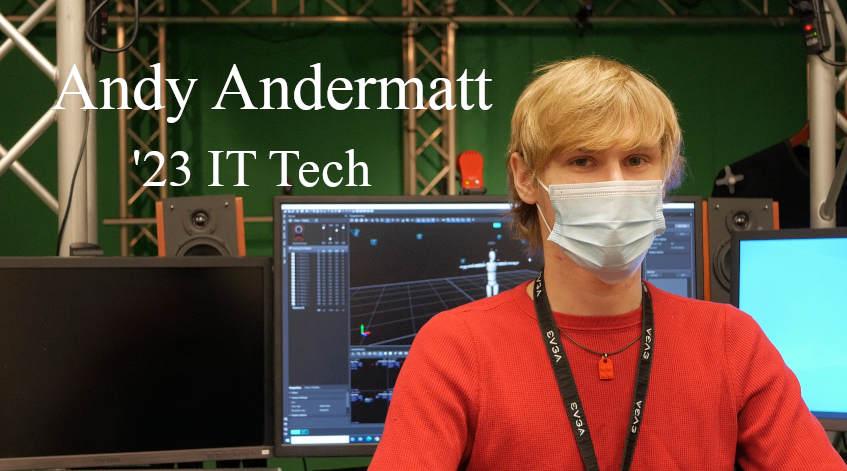The GRID Lab’s Motion Capture Room with IT Tech Andy Andermatt.
Andy Andermatt is a second-year Media Arts Production major who found a job position as an IT Tech at the GRID Lab. The role requires Andermatt to update software systems in the lab, install new computers and features and assist with virtual reality in the lab’s Motion Capture (Mo-Cap) Room.
During his first semester at OU, Andermatt took a VR class for his Learning Community and met Anthony Zoccola, GRID Lab and Projects manager at the McClure School. Andermatt spent last summer working with Zoccola on projects outside of the McClure School for Lantern Light Studios, LLC. He was then introduced to the tech position and started work in the GRID Lab.
“Having the opportunity to come here and work more with [the Mo-Cap Room], learn more about it and gain practical skills in the motion capture studio, even though it is very outside of my major, felt like a really amazing opportunity,” says Andermatt.
The Mo-Cap Room consists of a system of 16 cameras set up throughout the space that use a tracking system to capture markers on Mo-Cap suits. The cameras simultaneously film different angles of suit users, allowing them to move freely throughout the space. The GRID Lab’s Mo-Cap Room uses different software programs, like Unity and Unreal, that transform users into virtual entities.
“It uses all of the camera structures to combine together to track [users] location in a virtual space, so that [users] can be replicated and recorded or put into different programs,” says Andermatt.
In the Mo-Cap room, Andermatt invests time learning more about the system and helping students learn more about the software. He has created visual tutorials posted to YouTube and works with students in their courses to teach them the ins and outs of the Mo-Cap space and software.
Although a lot of his time is spent in the Mo-Cap room, Andermatt is also responsible for the other spaces the GRID Lab offers. He is tasked with updating computers and software features, reconfiguring the XR Lab space, and making sure programs that students need to create are in the system. Andermatt, along with co-workers in the GRID Lab, also recently implemented HP Reverb VR headsets in the main XR Lab.
“That was a big change, and we had to go through every computer, swapping out headsets,” says Andermatt.
The Mo-Cap room is also used for student to create their own projects. The Media Arts school hosts an event called ‘The 48’, which gives students in teams 48 hours to write, shoot and direct a 5-minute film. “[The event] is a really awesome example of some of the things motion capture can be used for,” says Andermatt.
The Mo-Cap room gives students the opportunity to not only learn about the software systems used in the VR field but also the ability to create. Students’ ideas and passions come to life in the space, and they can experiment with new concepts and technologies.
“Motion Capture has been used in games for 20 plus years,” says Andermatt. “[The Mo-Cap room] has become very integral because of the smoothness of motion and everything that you can capture with it.”
The McClure School of Emerging Communication Technologies strives to offer the best academic programs in the IT (Information Technology), the game development and the Virtual Reality/Augmented Reality (VR/AR) industries. Our programs and certificates cover numerous aspects of the rapidly changing industries of information networking, cybersecurity, data privacy, game development, digital animation and the academic side of esports.
